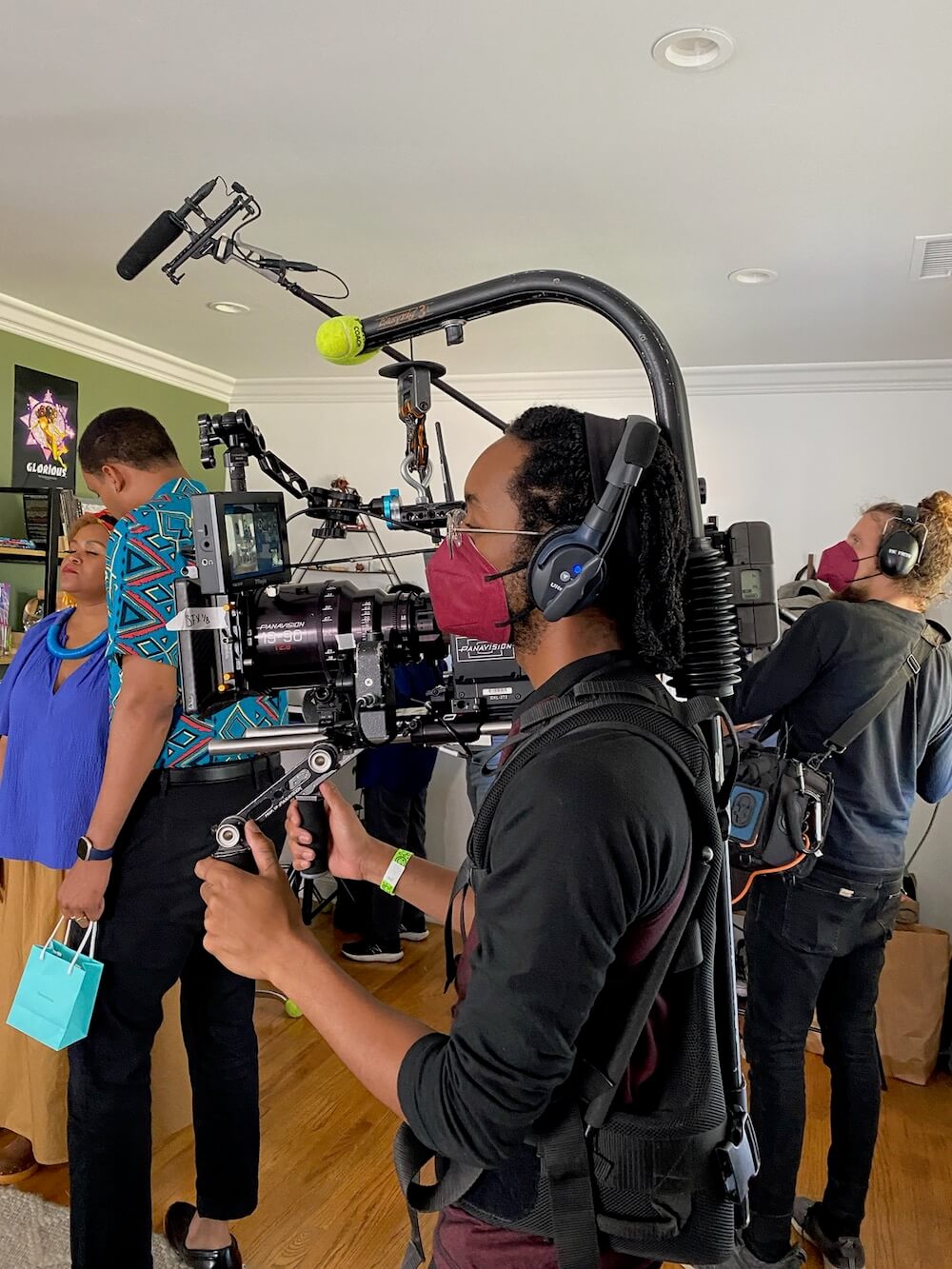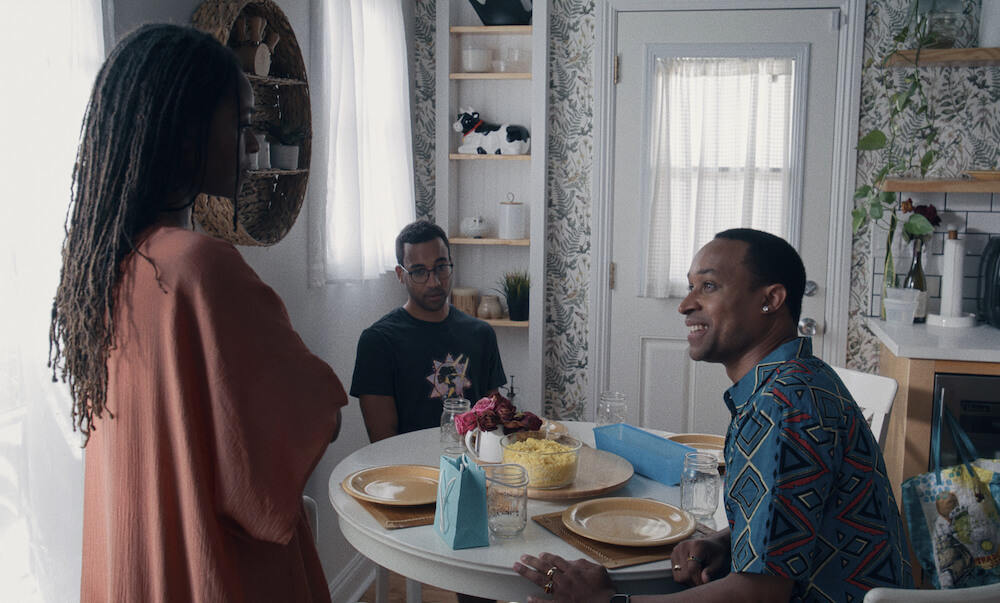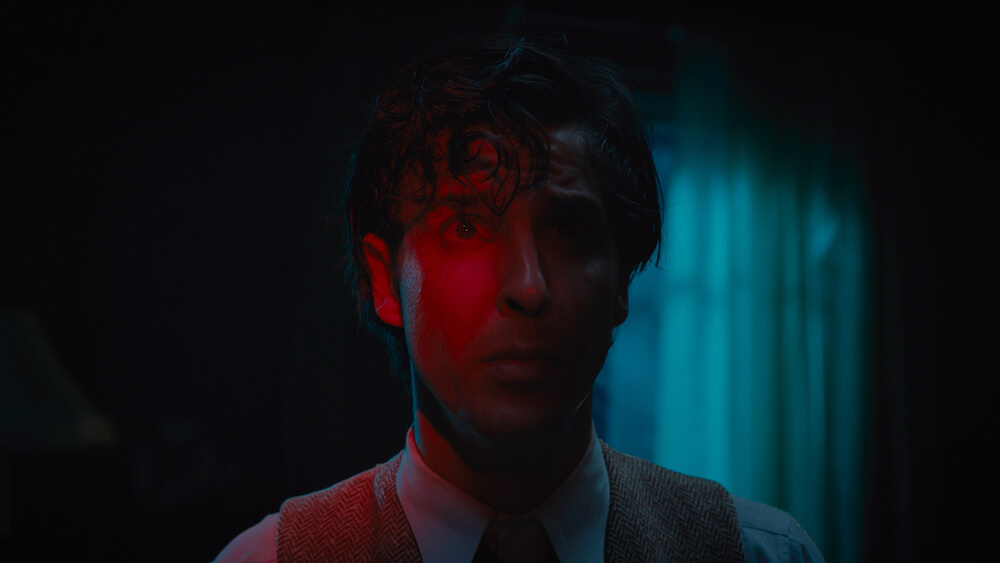Project Involve’s 2022 Cinematography Fellows

For three decades, Film Independent’s Project Involve has fostered filmmakers from underrepresented backgrounds, helping many of them — such as Jon M. Chu and Effie T. Brown — make the leap to long-lasting careers. The program gathers a diverse group of emerging film professionals for a nine-month program of industry mentoring and creative collaboration. Thirty new fellows were welcomed into the 2022 class, six cinematographers among them. Those cinematographers — Michael Tanji, Akina Van de Velde, Phillip Jackson, Lidia Nikonova, Gemma Doll-Grossman, and Garland McLaurin — each joined a writer, producer, director, editor, and executive in developing and making a short film.
Five of those projects — The Bluest Hour (shot by Nikonova), Expectant (Doll-Grossman), The Words of Cayetano (Tanji), No Vows, No Cows (Jackson) and Sabor (Van de Velde) — were live action, while the sixth, Muro (McLaurin), was animated via stop motion. As a principal sponsor of Project Involve, Panavision supplied each of the live-action productions with a camera and lens package. The final projects reveal fresh and eclectic imaginations at work, heralding a new generation of artists into the medium.
Origin Stories
The six cinematographers brought a multitude of personal and professional experiences to their projects, as each came to their craft in a unique way. For Akina Van de Velde, who spent the last 10 years creating video content for clients such as Adidas, Buzzfeed and Condé Nast, photography was her gateway to cinematography. “My parents traveled a lot for work when I was growing up, so I had the lucky opportunity to grow up in many different countries,” she says. “But sometimes it was lonely as a kid trying to learn a foreign language or adapt to a new environment quickly. Pretty early on I recognized my love for photography could transcend cultural or language barriers and that there was a common ground behind all the people I met. Storytelling is an extension of that connection, of building bridges between cultures and people regardless of where we come from or our backgrounds.
Phillip Jackson has documented the Black Lives Matter movement with his camera and shot the comedy feature Three Ways that premiered at the 2022 American Black Film Festival. His childhood passions sent him on the path to become a cinematographer. “What inspired me to start my filmmaking journey was the love of watching cartoon TV shows and playing video and board games growing up,” he says. “Since the fidelity of those old games and cartoons weren’t nearly as high quality as feature films, you had to fill in the blanks. Without knowing it, I was always making movies in my head. Getting to help shape those images now is a dream job.”
 Gemma Doll-Grossman on the set of Expectant.
Gemma Doll-Grossman on the set of Expectant.
Gemma Doll-Grossman graduated from Wesleyan University with degrees in biology and film studies and then received an MFA in cinematography from the American Film Institute Conservatory. Fluent in Italian, she worked in Italy for a few years, namely on Jonas Carpignano's Calabrian social-realist film trilogy. Doll-Grossman has lensed three features that are currently in post production, as well as the psychosexual short Scotty's Vag, which will premiere at the 2023 SXSW Film Festival. She is committed to capturing untapped perspectives and utilizing experimental techniques.
Garland McLaurin served as the co-director of photography on Wes Moore’s Coming Back documentary series and won a Peabody Award for co-producing and co-directing the 2013 PBS series 180 Days: A Year Inside an American High School. What attracted him to cinematography was his fascination with that most integral element of filmmaking: light. “I love what light gives you on a creative level,” he says. “As cinematographers, we are creative engineers or problem solvers, trying to bend the light and supply images that improve a story and satisfy your directors and audience. What keeps me inspired is the ability to grow creatively from project to project and the human connections we develop on set. I love studying light, images, art and good stories to enhance my development.”

Michael Tanji at the camera during production of The Words of Cayetano.
Hawaii-born and raised Michael Tanji has a background in fashion filmmaking and recently branched into music video and narrative work, but he originally imagined himself in a profession other than cinematography. “When I was younger, I thought I wanted to draw, paint, and become an architect for a living, but I realized I wasn’t very good at any of those things,” he says. “When I took my first high school video class and held a camera in my hands, the process of image-making came easier for me. Shooting video really opened my eyes to this visual medium because there was so much more you could do with the image when it left the page.”
Lidia Nikonova hails from Russia and has shot numerous films and commercials across the globe, most recently a documentary set to premiere on HBO Max. It was only after she was well into her career that she found cinematography to be her calling. “I tried several lives before converting into film,” she says. “I was a photojournalist and I also studied film theory, so I was interested in image-making and storytelling through images, though not necessarily by working with actors or writing dialogue. I’m one of those kids who grew up with a camera, so it was kind of natural. I just took a long way to get to the point where I knew, ‘Okay, this is it.’”
Visual Approaches
During preproduction, the cinematographers for the five live-action projects came to Panavision Woodland Hills to select and prep their camera and lens packages. “I’m beyond honored to have had Panavision’s support on the project,” Van de Velde reflects. “Everyone was incredibly helpful from beginning to end in ensuring that we had all the elements needed to make the film we wanted to make. It was absolutely one of the highlights of the experience.”
“I was excited when they told us Panavision was a sponsor,” agrees Jackson, who was the director of photography for No Vows, No Cows, director San-San Onglatco’s short about the generational culture clash between a mother and daughter. “I had only used their services once before as a film loader in my early years of working in Los Angeles. Getting to talk to [New Filmmaker Program manager] Aaron Saffa about our ideas and wants, and then him building a package around our discussions, was a cool change of pace for me and felt very collaborative. Our prep tech Edgar Torres also brought ideas to the table that helped us shape our package on the prep day. Their guidance spoke volumes about their knowledge of the gear and desire to make sure filmmakers have the tools they need to execute their vision.”
 Phillip Jackson operates the DXL2 on the set of No Vows, No Cows.
Phillip Jackson operates the DXL2 on the set of No Vows, No Cows.
Jackson, along with Van de Velde and Nikonova, selected Panavision’s Millennium DXL2 as the primary camera for their shorts. Each had unique reasons for their choice. “I wanted a camera that had great dynamic range but was well balanced, since it would be on my shoulder via an Easyrig for the whole shoot,” Jackson says.
“The look of No Vows, No Cows is heightened cinéma vérité as compared to the present-day world,” he continues. “We used a handheld camera that reacted to what was happening in the scene by moving and reframing to help elevate moments in the film so the viewer would feel like they were right in the family drama. We were lighting through windows that we would glimpse in the frame at times, so I didn’t want to be afraid of seeing those highlights while capturing Black actors all in the same frame.”

Frame grab from No Vows, No Cows.
For Van de Velde, capturing the location was of primary importance when shooting Sabor. She and director Jaime Castañeda drew inspiration from the feature Chef and how director Jon Favreau staged the characters in kitchens, from restaurants to a food truck. “Sabor is ultimately a family film that showcases the nuances of two sisters and the relationship they have within the confines of their family bakery,” Van de Velde says. “The look was dictated by the need to be authentic to the location, but also to highlight the love between the sisters. We wanted the location to feel like a character, an extension of the parents whom the sisters have lost, so the film has a warmth and golden glow that permeates throughout the kitchen space.
“The combination of the DXL2 sensor and Super Speed ‘Z’ prime lenses was able to toe the line in softening the image while also seeming current and modern in sharpness, so as to not dull the kitchen and bakery itself,” she continues. “Also, the DXL2 is an incredible tool for a DP and is designed to optimize the cinematography process.”

Frame grab from Sabor.
The short The Bluest Hour tells the story of a young couple fighting among themselves while their newborn son fights for his life. To bring out the conflict visually, Nikonova aimed for a look she describes as “surrealist, dark, pensive, and enigmatic.” She and director Logan Jackson spent much of their first conversations talking about blues music and how they could commit that feeling to images. They also bonded over a film they both love, If Beale Street Could Talk. “We asked ourselves, ‘How would this kind of beauty and this elevated feeling of a visually pleasing image work with our ideas of Afro-surrealism and other films that lean into the territory, like Nope or Us, where there are more elements for you to solve?’ Our short tries to merge these worlds of beauty and poetry and Afro-surrealism.”
As a former student at AFI, Nikonova already had a history with Panavision, and her experiences helped shape her choices for The Bluest Hour. “We knew this was going to be a very dark film, and that enabled me to be bolder with my lighting,” she says. “That’s why we went with the DXL2 camera, which has a native ASA of 1600. Paired with Super Speed and Ultra Speed lenses, the DXL2 proved perfect for night interior and night exterior work on a budget. I felt confident telling our team that if we want to shoot everything at night, we can do it. Having such a sensitive sensor on the DXL2 and such fast glass was perfect.”

Lidia Nikonova frames up the production's DXL2 on location for The Bluest Hour.
For Expectant, Doll-Grossman and director Hannah Bang wanted to emphasize the visual qualities of heat. In telling their story about a soon-to-be father, Ben, struggling with his identity in an environmentally unstable world, they drew inspiration from the warm, desaturated tones of Matthew Libatique, ASC’s cinematography for Darren Aronofsky’s Mother! and Bradford Young, ASC’s low-key lighting in J.C. Chandor’s A Most Violent Year. Their choice of Primo lenses proved imperative to crafting the look they desired.
“Aaron Saffa at Panavision ensured that we had the time and space to test different Primo sets to find the right lenses that could feel naturally ‘hot,’” Doll-Grossman says. “We were specifically looking for gentle halation around point sources and strong green and yellow flares. The Primo 11:1 zoom enabled Hannah and I to design long, surveilling shots of Ben at work in his woodshop, to imply an external force watching him. We wanted to emphasize the presence of a monster without ever seeing it, because the monster is actually Ben’s crippling anxiety and ambivalence towards bringing a child into an inhospitable environment.

Frame grab from Expectant.
“Collaborating with other departments to underline heat was also crucial,” Doll-Grossman continues. “Production designer Marina Perez brought in mustards, tans, golds and pops of red, and she eliminated blues and other cool tones. Hair and makeup and wardrobe gave our characters their necessary sweat. We also experimented with heat-wave effects by putting a butane camp stove with a thick flame in front of a long lens for a couple shots. We were inspired by some of the desert mirage effects in Lawrence of Arabia.”
Tanji also selected Primo primes for The Words of Cayetano, about a writer who must confront the muses and beasts of his imagination. When discussing what their visual approach would be for their short, Tanji and writer-director Jesus Celaya cited the horror films of Mario Bava and Dario Argento. The Italian directors’ bold use of color informed the decisions Tanji and Celaya made and led to an aesthetic they called “heightened realism,” Tanji explains.

Frame grab from The Words of Cayetano.
“We were looking for ways to emphasize a particular character’s emotions or shifts in the story through our lighting choices, and color was a characteristic we paid a lot of attention to,” he says. “For example, we first determined that we wanted our moonlight in the natural world to be a cold but lighter shade of blue. When things turn strange and our protagonist, Cayetano, gets thrown into a more surreal world, we went for teal-colored moonlight with extra green so that the world feels a little more sickly.
“I wanted the viewers to see the world in which this story takes place with an unobstructed view,” Tanji adds. “So much is conveyed in the beautiful dialogue that Jesus wrote, and I was looking for lenses that would reflect the performance of our actors, who take center stage and emotionally drive the story. I chose the Primo lenses for their great contrast range, low distortion, and controlled flare quality that still complements the image. They are also sharp lenses that render the image with a very cinematic quality, and the focus falloff is very painterly.”
Garland McLaurin had shot multiple award-winning documentaries, television series and narrative shorts, but never anything in the realm of animation until he partnered with writer-director Javier Barboza on the stop-motion short Muro. “The premise behind Muro — of a young Latina migrant encountering a Humpty Dumpty bureaucrat on a massive desert wall — spoke to my storytelling sensibilities,” McLaurin says. “It was an offbeat project that felt different from traditional narrative storytelling in short films. When I became involved in the short, I began to imagine the visual possibilities around the topic and the character’s journey. I also thought the challenge of shooting stop-motion animation would be a process I could learn from.”

Frame grab from Muro.
McLaurin and Barboza turned to other animated films for inspiration. “The Little Prince was a reference point provided by Javier in terms of the stop-motion visual style of animation,” McLaurin says. “I also watched the classics The Nightmare Before Christmas and Fantastic Mr. Fox to study how they meshed the visual elements and storytelling components.”
Just as he would do on a live-action project, McLaurin coordinated changes in color and lighting to set the story’s mood and establish its world. “Javier envisioned a dystopian feel for a fairytale story,” McLaurin says. “Our initial discussions around color tones turned toward warmer yellow and orange hues. Muro takes place in the desert, so we discussed when and where to use hard light versus softer light at specific story points. We also used layered textures like desert sand as an overlay to enhance the story.”
Authentic Voices
Though the cinematographers applied different methods and approaches in shooting their projects, what stands out as a unifying characteristic among all six shorts is an authentic voice. Their images speak to a host of issues and themes, from politics and aesthetics to gender and identity.
For Nikonova, cinematography is a vehicle to express her feelings about the people and things culture has marginalized. The Bluest Hour fit her voice well because the short is about characters on the outskirts of society who have experienced medical racism and are therefore scared for the life of their ailing newborn. “I’m an immigrant queer woman,” she shares. “I feel it’s my job to be aware of what has been erased and keep pushing for more open, powerful visual language — to try to rethink the language so it speaks of all that we’ve never seen.”

Frame grab from The Bluest Hour.
Similarly, shooting No Vows, No Cows gave Jackson a canvas primed for his perspective. “As a Black cinematographer, I don’t often get to work with a full Black cast,” he says. “It’s hard for me to put my feelings into words, but there’s an unspoken weight that’s lifted when working closely with actors I feel a shared history and background with. Having an opportunity to take the skills I’ve built on previous projects — like the feature I shot, Three Ways, which had an all-Black lead cast — and continue to hone those skills while being in community with others like me was really rewarding.”
Indeed, the relationships built with their collaborators made the Project Involve experience particularly rewarding for all of the cinematography fellows. As Van de Velde attests, “My introduction to a new family and community of collaborators, all of whom share interests and are so talented, has been invaluable to me. I’ve made new friends and mentors with whom I hope to continue be able to work and grow, both professionally and personally.”

Akina Van de Velde (right) on location for Sabor.